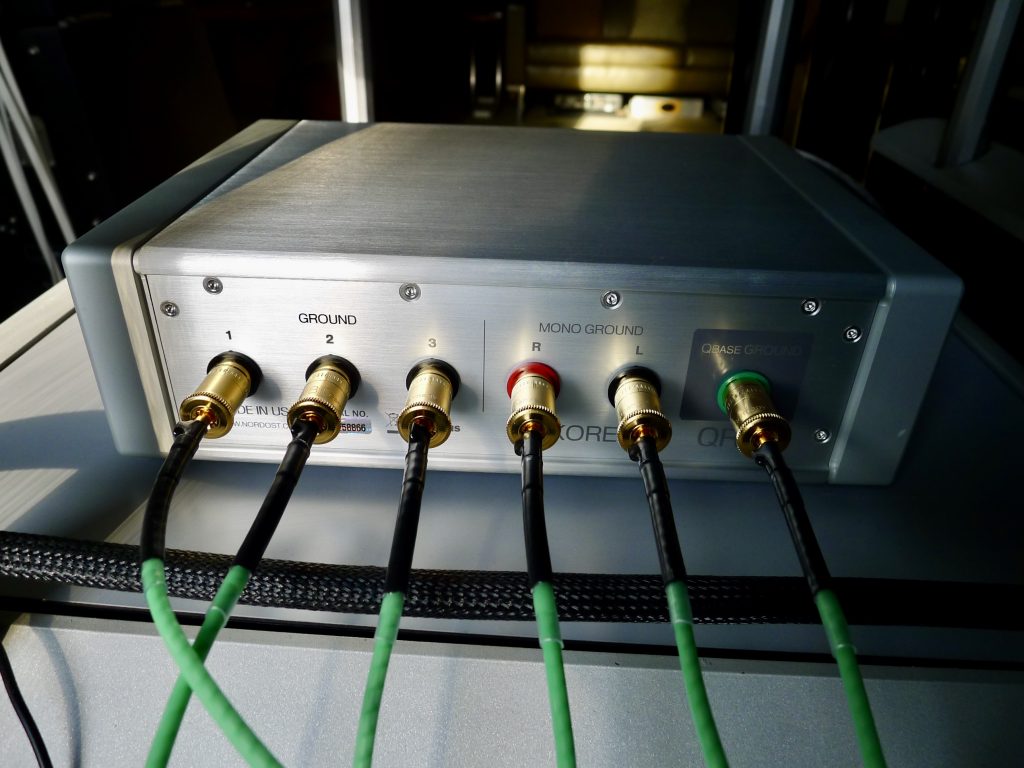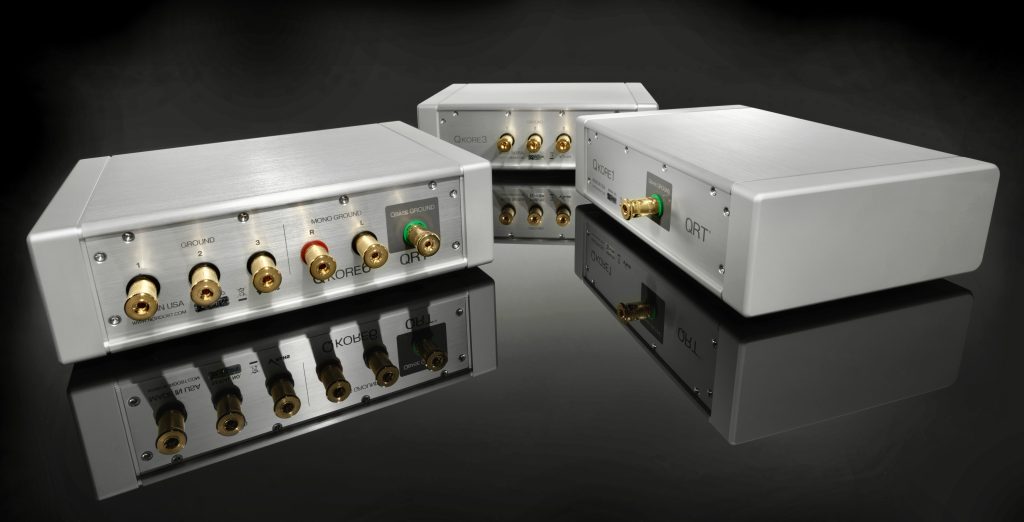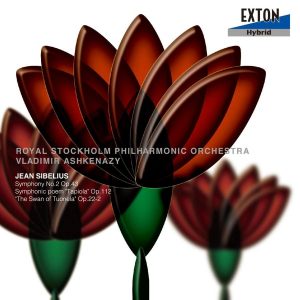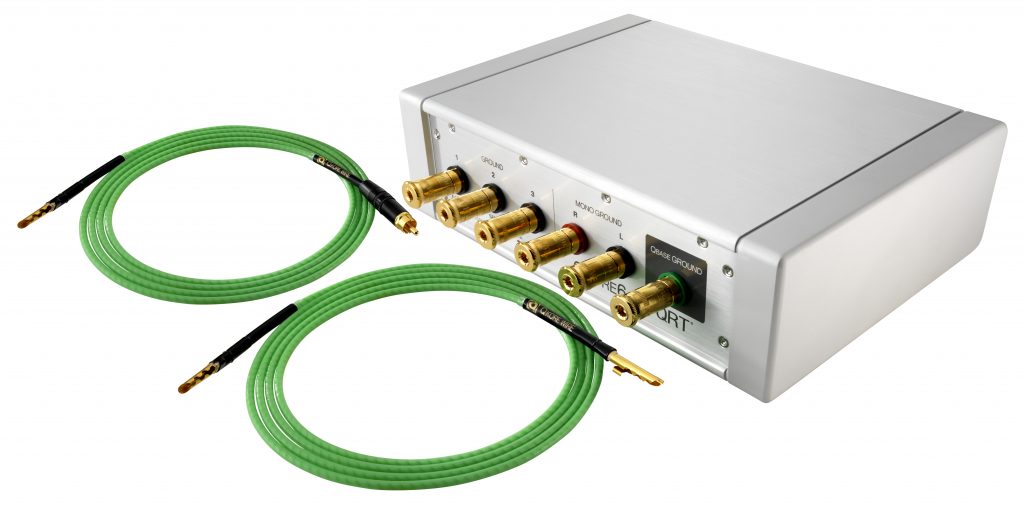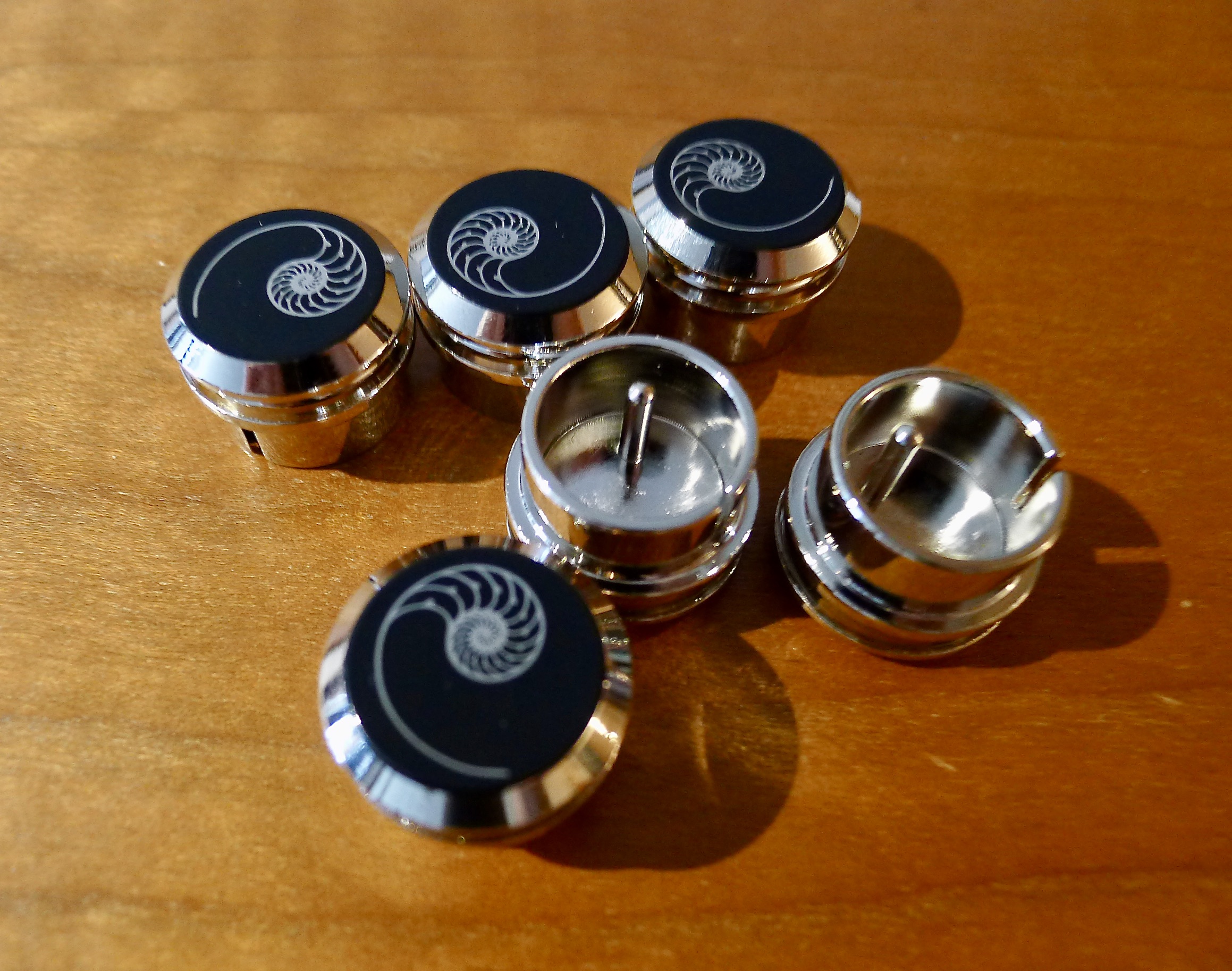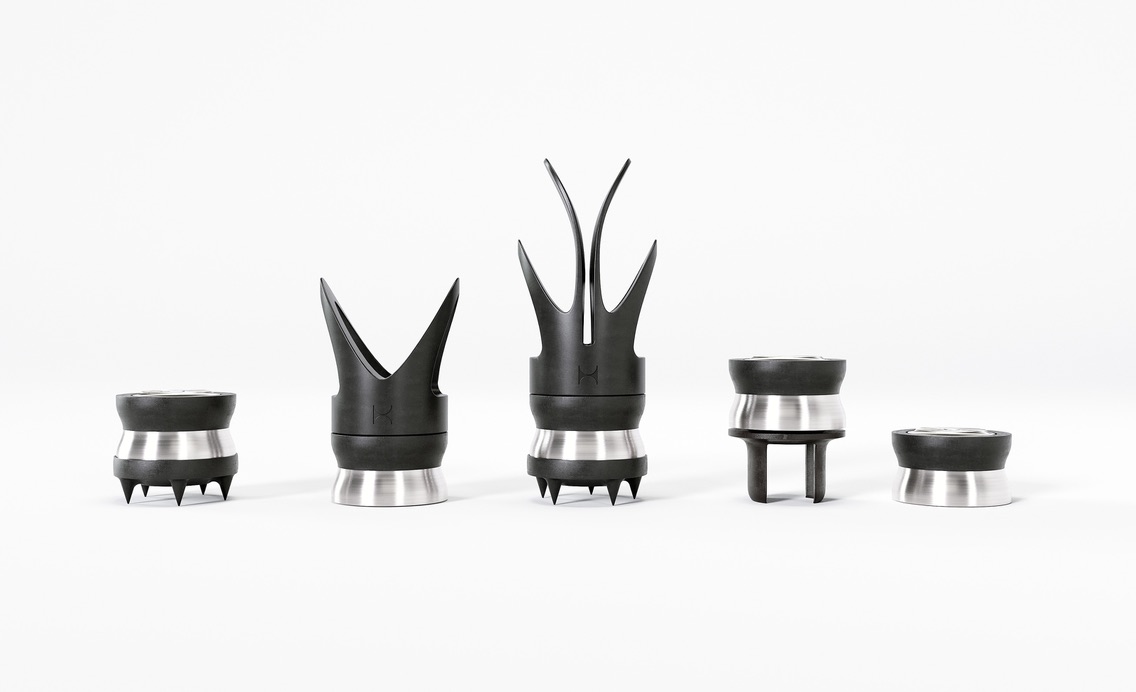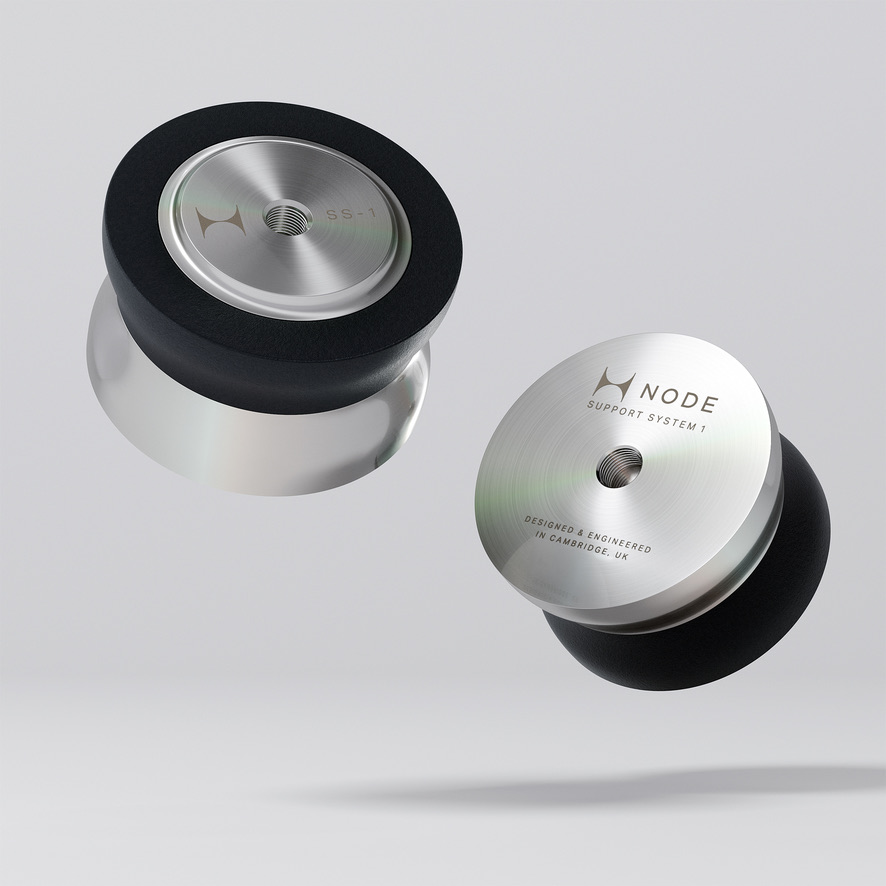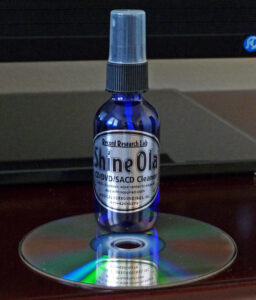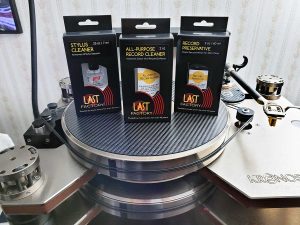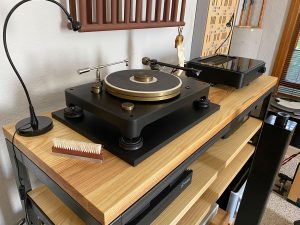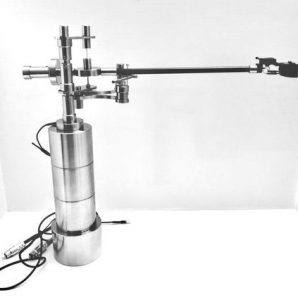The telltale sign that everything was right—better-than-right—appeared when I set my CH Precision M1.1 monoblocks to produce a flat response, meaning bass, mids, and treble were output in equal measure, just as they were designed to do at the factory. Previously, I had found it necessary to boost the mids (or lower the treble) to get a satisfying tonal balance. (The CH M1.1 amps have flexibility to make these adjustments.) But this had the unforeseen consequence of leaving my gut mildly unsettled. Something in the sound, possibly related to phase, was off kilter. Installing the QKORE Ground Product from Nordost purged the brightness that I was compensating for and allowed me to reset the amps. Theoretically, this was good. More importantly, my gut confirmed it. But, I'm getting ahead of myself here. Let's start at the beginning of the story.
The Ground Factor in Audio
Quite a while ago, I noticed benefits when components that talk to each other—such as the transport, DAC and master clock, or the phono stage and turntable motor—were plugged into the same AC wall outlet (or power distributor). I speculated it had something to do with them seeing the same AC ground from the wall. That's a guess, but the improvement was real, and it reinforced the notion that something important was going on with the electrical ground.
It then occurred to me that the concept could be upscaled system-wide by running a wire from each component to a central, common point. However, nobody was making such a product at the time. To my knowledge, the need went unaddressed for North American consumers until a Swedish company called Entreq began appearing in the online Audiogon tweak marketplace a couple of years ago. I investigated their intriguing offerings, but I never followed up. Why? Aesthetically, I did not relish adding a half dozen wires to the pile of spaghetti behind my rack.
Meanwhile, third-party grounding solutions took off and major players jumped in. Nowadays, the idea of attaching components to a central artificial earth is not eccentric; many serious audiophiles consider this an essential piece of their reference system. And then a trusted source gave the Nordost QKORE solution a thumbs up within the context of his CH Precision system and that clinched it.
EMI/RFI Dumpster Approach
All of these ground products are addressing the same issue—environmental EMI/RFI artifacts that attach to the ground pathway of power cords, signal cables, and components. They each approach it from a slightly different angle. The Entreq design uses a box full of organic material to simulate a natural earth ground. Each component connected to it dumps minuscule ground pollutants into this box, where it is stored, and at some point discharged, rather like an organic capacitor.
Similarly, the Nordost QKORE is a central, common point of connection for all your components. Because ground tends to flow in the direction of least resistance (unlike music signals, which follow a path from component to component), Nordost developed very low resistance wires to connect the component to the QKORE. High frequency noise and voltage-generated magnetic fields riding on the ground inside the component are attracted to these QKORE Wires and travel down into the QKORE, where they are deposited at a Low-Voltage Attractor Plate (LVAP), the dumpster. When you think about it, the Nordost design is simple and ingenious: the ground pollution just follows the path of least resistance out of the component and into the LVAP.
In the bigger picture, the complete solution should address ground noise at two points: the AC from the wall and the DC current inside the component. Think of these as pre-transformer (AC) and post-transformer (DC). The QKORE1 has a single banana jack intended for connection to a ground lug on a power conditioner/distributor bar and taps the AC ground. The QKORE3 has three banana jacks to address the DC ground on three components by plugging QKORE Wires into an unused RCA or XLR jack on each. Note that the LVAPs in these units are identical: they can handle either AC or DC. The only rule to keep in mind is don't commingle both AC and DC on one LVAP.
While the QKORE1 and QKORE3 have a single LVAP inside, the QKORE6 has two and is designed to handle AC and DC. The banana jack on its chassis labeled QBASE GROUND has a dedicated LVAP and should go to a power conditioner/distributor (tapping the AC ground). The remaining five jacks terminate in the other LVAP and are suitable for source components or amplifiers (the DC ground). Follow the instruction manual.
The QKORE units are passive devices; they don't plug into the wall. The chassis are very well constructed, resonance tuned, and somewhat heavy. The QKORE6 weighs 17 lbs, mostly due to the two LVAPs. There is a short burn-in time. After installation, the QKORE is a bit dark and tight. Give it a day and it will lighten up and get more limber. Even though the chassis advertises QRT (a Nordost proprietary sound enhancement process), there are no QRT components inside.
Sound Observations
By far, the biggest change was purging the brightness I had been compensating for. The QKORE straightened out the frequency balance, allowing me to set my amps to deliver a flat response. In the process it smoothed out roughness in the treble and the system acquired an amazing low-end. You want more weight in your sound? No problem! The bass retains the characteristics it had before, i.e., it doesn't get warm or bloated, but gains body, density, and sheer quantity. Dense symphonic passages scored for multiple instruments playing in the lower register had often congealed into a generalized buzz from the woofers. The QKORE unpacked these frequencies and opened a view revealing unsuspected subterranean lifeforms. This newfound discrimination in the low-end was profound: it drew unanimous accolades from my listening panel.
Soundstage Occupancy
The way the QKORE smoothed out the treble helped make less than perfect recordings easier to listen to. But play a really fine recording, like Sibelius - Symphony No. 2 (Japanese Exton OVCL-00292, SACD), and your perception of the stage alters in a fundamental way. With the tag-team forces of transparency and resolution going full bore, a stealthy quality of animation made its appearance.
I sometimes review gear that ratchets up the information level to an uncomfortable degree, occasionally triggering a sensory overload. (This always goes away after a day or two. It seems there is no such thing as too much information.) Plus I'm used to gear that allows instruments independent action. For example, when the score has many lines going at once, with some parts getting louder and some softer. The system then has to multi-task. But some key element was missing; nobody would mistake my scaled-down replica for an exact copy of the real thing.
The QKORE fleshed out this critical shortfall by exposing a variety of accents and dynamic markings finer than those already present. Subtle shadings on the level of mf (mezzo forte) or mp (mezzo piano) were revealed between forte, mezzo, and piano. As gaps were filled in transitions became smoother, more fluid and mobile, less mechanical. This allowed the music to breathe easily and deeply. Even sustained notes revealed a degree of interior life.
Many people have the impression that solid-state is dry, less liquid than tubes. In the main that is true. However, given a fine recording and the QKORE in stream, you wouldn't be so quick to come to that conclusion. The large images in the front of the room are moving about quite naturally—not stiffly—and they occupy the stage almost like there's a live group up there. As the activity unfolds, it makes for a very lively entertainment. This is something I've not encountered before; it is on the level of a breakthrough.
QKORE Wires: What Connector Should You Use?
"The QKORE Wire is constructed to provide the path of least resistance to ground for the stray, high-frequency, low-voltage potentials… [It] utilizes Nordost's patented Micro Mono-Filament technology, combined with extruded FEP insulation, and constructed with a 16 AWG, silver-plated OFC, solid core conductor. The QKORE Wire can be terminated with the following connectors: spade, banana, male-XLR, female-XLR, BNC, RCA, USB A, USB B, and RJ45."
Let's say your preamp has unused RCA and XLR Input/Outputs. Which should you connect the QKORE wire to? There is no way to tell up front—the QKORE's effectiveness is variable. You will find connection to an output jack gives a more powerful effect—or maybe an input is better. Likewise, you can't assume the RCA will be more effective than the XLR. You have to try both types.
Round One: QKORE on the Components
For the first round, I used a QKORE3 and QKORE6 to connect all of my CH Precision components. For the D1 Transport, the QKORE Wire was best on the XLR DIG_OUT jack; the C1 DAC liked connection to an XLR on the DIG_IN jack. For these two, tapping the XLR jack gave more bass, wider dynamics, and increased stage width (as opposed to the RCA). The L1 Preamp and the P1 Phono Preamp had a preference for the RCA on an input jack. The T1 Clock showed minor improvement when connected to a QKORE BNC wire, not as big as the other components. My Ethernet network switch got a nice boost with an RJ45 terminated QKORE wire.
Here's a nice, little tip: whenever I'm not streaming via Ethernet, I unplug the QKORE RJ45 wire from the network switch and move it to the Ethernet jack on the C1 DAC. This is in addition to the QKORE XLR wire already on the DIG_IN jack. In effect, I'm doubling up QKORE treatment on the DAC. Additional benefits accrued. (Be vigilant, though, about over-doing it to the point where all the sparkle goes away and the sound becomes dull.)
Another tip: in all cases, I made sure that unused Input/Output jacks were covered with RCA or XLR caps from Cardas Audio (read that review HERE). RFI is insidious and will find its way into any opening. Capping unused jacks seals off entry points and gives similar effects to the QKORE, if smaller in degree.
Round Two: QKORE on the Power Distributor
After a week getting acquainted with QKORE on all my components tapping the secondary (or post-transformer DC) ground, I installed a QKORE1 on my HB Cable Design power distributor to get to the primary (or pre-transformer AC) ground. The HB power distributor is dedicated to my amps. (Note: the power conditioner/distributor must have a ground lug to enable connection to the QKORE.) This left the rest of my components untreated, because they are connected to early versions of the Kubala-Sosna XPander distributor which doesn't have a ground lug.
Round Two compounded the impact of Round One, adding stability and sheer mass to the instruments. Take it away and the bass and midrange seem a little fuzzy, not as well delineated. Additional treble brightness was purged with tonal balance shifting a little darker, richer. I particularly noted the naturalness of woodwind instruments. While not the big bang of the Round One QKORE on the components' inputs, purging the grunge on my HB Cable Design power distributor was certainly worthwhile. Perhaps if installed in the reverse order, it would have been the big one. (And remember, I only took care of my amps. All of the front-end components AC ground was still untreated.)
Sort Kones
I admit to a degree of befuddlement when I read Nordost recommends replacing the stock soft rubber feet under the QKORE chassis with their Sort Kone product. The Sort Kone is a tuned resonance control device that acts as a mechanical diode to drain the resonant energy out of a chassis. It has a three-part construction: a vertical metal post with a spike point on top; a bottom base made of matching metal; and a hardened ceramic ball bearing under compression between the two metal parts. The choice of metals (aluminum, bronze, or titanium) gives you a lot of options.
A set of isolation footers under an accessory chassis that only interacts with a trickle current of ground pollution? Sure! I went through the variations under each QKORE chassis (as well as a couple of other footers, too). Yes, each Sort Kone altered the sound in distinctive ways, which were not subtle. The aluminum/ceramic ($88.99/each) promoted focus and clarity, but seemed to vacuum up too much air. The bronze/ceramic ($157.99/each) was full bodied, warm, and boosted lower midrange and bass. The titanium/ceramic ($388.99/each) was explosively dynamic with tight, articulate bass, and favored the frequency extremes.
But sometimes you can't see the forest for the trees. In the end, our preference was for none of the above. The squishy rubber bumpers that come with the product provided good frequency integration and enough focus to do the job.
(It's worth mentioning that, while the Sort Kones can be used under the QKORE units, they are primarily intended to go under components.)
Conclusion
In advance of installing the QKORE Ground Units, I had imagined what such a product might accomplish. Those daydreams were prophetic—the only surprise was how significant it turned out to be.
The QKORE products brought deep insights and expanded my listing pleasure greatly. While not cheap (three QKORE boxes to achieve the level of coverage described above ran about $11K, plus the wires), it did more to improve my sound than any alternative I can think of at that price. For guys with ultra systems, where $11K might buy you a wire or two (not even a component), the QKORE represent good value. I'm sure mid-level systems would benefit as well, but here the competition for those dollars is more intense.
I am reticent to say it, but once you try them, you might find the QKORE Ground Products as indispensable as I did. This is the kind of upgrade that doesn't come along every day.
QKORE1
Retail: $2499.99 power cords not included
QKORE3
Retail: $3499.99
QKORE6
Retail: $4999.99
QKORE Wire
Retail: $360/2 meter; $150 per additional meter.
Sort Kone: Aluminum/Ceramic
Retail: $88.99/each
Bronze/Ceramic
Retail: $157/each
Titanium/Ceramic
Retail: $388.99/each
Nordost






